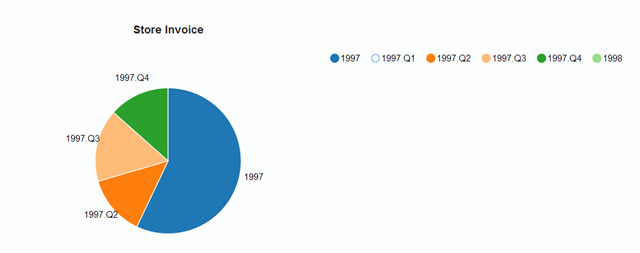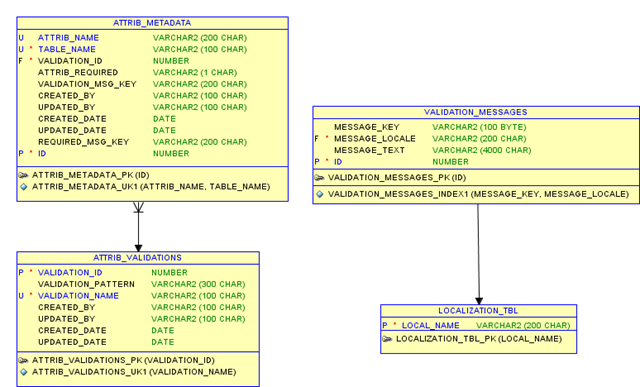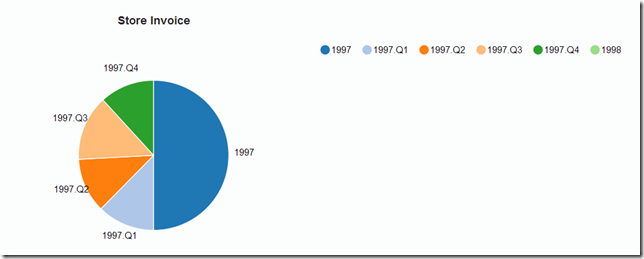Recently a user contacted me with the requirement that he needed to assign enterprise groups to application roles dynamically. Normally, people can manage this through enterprise manager, but there might have been a specific requirement for that user. I have already written various posts on ADF security which cover utility methods that use OPSS API’s to perform operations on the enterprise OID, OpenLdap etc. In this post i will cover this specific requirement; although the given code is very crude, it is there only to serve as an example and the process is what matters.
The code is shown below.
package model;
import oracle.security.jps.service.policystore.ApplicationPolicy;
import oracle.security.jps.service.policystore.PolicyStore;
import java.security.Principal;
import java.util.Hashtable;
import oracle.adf.share.logging.ADFLogger;
import oracle.security.idm.IMException;
import oracle.security.idm.IdentityStore;
import oracle.security.idm.IdentityStoreFactory;
import oracle.security.idm.IdentityStoreFactoryBuilder;
import oracle.security.idm.Role;
import oracle.security.idm.RoleManager;
import oracle.security.idm.User;
import oracle.security.idm.UserManager;
import oracle.security.idm.providers.oid.OIDIdentityStoreFactory;
import oracle.security.jps.JpsContext;
import oracle.security.jps.JpsContextFactory;
import oracle.security.jps.JpsException;
import oracle.security.jps.internal.idstore.ldap.LdapIdentityStore;
import oracle.security.jps.service.idstore.IdentityStoreException;
import oracle.security.jps.service.idstore.IdentityStoreService;
import oracle.security.jps.service.policystore.ApplicationPolicy;
import oracle.security.jps.service.policystore.PolicyObjectNotFoundException;
import oracle.security.jps.service.policystore.PolicyStore;
import oracle.security.jps.service.policystore.PolicyStoreException;
import oracle.security.jps.service.policystore.info.common.InvalidArgumentException;
public class DemoJpsMethods {
public static final ADFLogger DemoJpsLogger=ADFLogger.createADFLogger(DemoJpsMethods.class);
public static final String DEV_GROUP="DevGroup";
public static final String TRAINING_GROUP="TrainingGroup";
public static final String DEV_APP_ROLE="DevAppRole";
public static final String TRAINING_APP_ROLE="TrainingAppRole";
public DemoJpsMethods() {
super();
}
/**
* Dummy method just for testing so not parameterized
*/
public void addUserToAppGroup(){
JpsContext ctxt = IdentityStoreConfigurator.jpsCtxt;
LdapIdentityStore idstoreService =
(LdapIdentityStore)ctxt.getServiceInstance(IdentityStoreService.class);
IdentityStore idmStore=null;
try {
idmStore = idstoreService.getIdmStore();
} catch (IdentityStoreException e) {
throw new RuntimeException(e);
}
User tom=null;
User helen=null;
UserManager um=null;
RoleManager rm=null;
Role trainingRole=null;
Role devRole=null;
try {
um= idmStore.getUserManager();
rm=idmStore.getRoleManager();
} catch (IMException e) {
try {
idmStore.close();
} catch (IMException f) {
}
throw new RuntimeException(e);
}
try {
trainingRole =
idmStore.searchRole(IdentityStore.SEARCH_BY_NAME, TRAINING_GROUP);
devRole =
idmStore.searchRole(IdentityStore.SEARCH_BY_NAME, DEV_GROUP);
} catch (IMException e) {
DemoJpsLogger.severe("Rethrow exception because roles ARE NOT found");
try {
idmStore.close();
} catch (IMException f) {
}
throw new RuntimeException(e);
}
try {
tom = idmStore.searchUser("tom");
helen = idmStore.searchUser("helen");
//if it comes till here user is found
} catch (IMException e) {
DemoJpsLogger.severe("Ignore exception because user is likely not found");
}
//User not found create ?
if(tom==null){
try {
tom= um.createUser("tom", "Welcome_1".toCharArray());
} catch (IMException e) {
try {
idmStore.close();
} catch (IMException f) {
}
throw new RuntimeException(e);
}
}
//User not found create ?
if(helen==null){
try {
helen=um.createUser("helen", "Welcome_1".toCharArray());
} catch (IMException e) {
try {
idmStore.close();
} catch (IMException f) {
}
throw new RuntimeException(e);
}
}
try {
rm.grantRole(trainingRole,tom.getPrincipal());
rm.grantRole(devRole,helen.getPrincipal());
} catch (IMException e) {
try {
idmStore.close();
} catch (IMException f) {
}
throw new RuntimeException(e);
}
if(idmStore!=null){
try {
idmStore.close();
} catch (IMException f) {
}
}
}
public void addAppGroupToAppRole() {
JpsContext ctxt = IdentityStoreConfigurator.jpsCtxt;
LdapIdentityStore idstoreService =
(LdapIdentityStore)ctxt.getServiceInstance(IdentityStoreService.class);
IdentityStore idmStore=null;
try {
idmStore = idstoreService.getIdmStore();
} catch (IdentityStoreException e) {
throw new RuntimeException(e);
}
PolicyStore ps = ctxt.getServiceInstance(PolicyStore.class);
ApplicationPolicy policy;
Role trainingRole=null;
Role devRole=null;
try {
trainingRole =
idmStore.searchRole(IdentityStore.SEARCH_BY_NAME, TRAINING_GROUP);
devRole =
idmStore.searchRole(IdentityStore.SEARCH_BY_NAME, DEV_GROUP);
} catch (IMException e) {
try {
idmStore.close();
} catch (IMException f) {
}
throw new RuntimeException(e);
}
try {
policy = ps.getApplicationPolicy("DemoAppSecurity#V2.0");
policy.addPrincipalToAppRole(trainingRole.getPrincipal(), TRAINING_APP_ROLE);
policy.addPrincipalToAppRole(devRole.getPrincipal(), DEV_APP_ROLE);
} catch (PolicyStoreException e) {
throw new RuntimeException(e);
} catch (IMException e) {
throw new RuntimeException(e);
}
if(idmStore!=null){
try {
idmStore.close();
} catch (IMException f) {
}
}
}
/**
* This nested private class is used for configuring and initializing the context factory
* @author Ramandeep Nanda
*/
private static final class IdentityStoreConfigurator {
private static final JpsContext jpsCtxt=initializeFactory();
private static JpsContext initializeFactory(){
String methodName = Thread.currentThread().getStackTrace()[1].getMethodName();
JpsContextFactory tempFactory;
JpsContext jpsContext;
try {
tempFactory=JpsContextFactory.getContextFactory();
jpsContext=tempFactory.getContext();
}
catch (JpsException e) {
DemoJpsLogger.severe("Exception in "+methodName + " " +e.getMessage() +" ", e);
throw new RuntimeException("Exception in "+methodName + " " +e.getMessage() +" ", e);
}
return jpsContext;
}
}
}
So basically there are two methods, the first one just creates the user and assigns them to the enterprise groups, the second one is the one we’re interested in because this one first accesses the application policy and then dynamically assigns the enterprise group to the application role .
We are not done just yet, there are a few steps you need to configure which are mentioned below.
- Assign PolicyStoreAccessPermission to weblogic user in system-jazn-data.xml.
<grant>
<grantee>
<principals>
<principal>
<class>weblogic.security.principal.WLSUserImpl</class>
<name>weblogic</name>
</principal>
</principals>
</grantee>
<permissions>
<permission>
<class>oracle.security.jps.service.policystore.PolicyStoreAccessPermission</class>
<name>context=SYSTEM</name>
<actions>*</actions>
</permission>
</permissions>
</grant>
- Although i have added the application stripe grant in the application jazn-data.xml, you need to be aware of that. It is mentioned below:
<grant>
<grantee>
<principals>
<principal>
<class>oracle.security.jps.internal.core.principals.JpsXmlUserImpl</class>
<name>weblogic</name>
</principal>
</principals>
</grantee>
<permissions>
<permission>
<class>oracle.security.jps.service.policystore.PolicyStoreAccessPermission</class>
<name>context=APPLICATION,name=DemoAppSecurity#V2.0</name>
<actions>*</actions>
</permission>
</permissions>
</grant>
- Run the application and log in with weblogic user i.e login.html page
- There will be two buttons one creates and adds a user to a group, second adds enterprise group to app role
- For first, You need an ldap browser to view the changes, use the embedded ldap connection details.
- For second, you need just to view the system-jazn-data.xml file, here you will see enterprise group added to app role.
The application can be downloaded from here. Application Link












